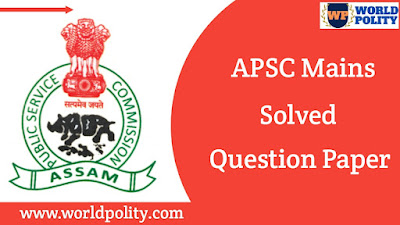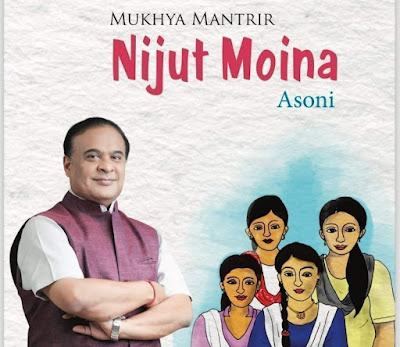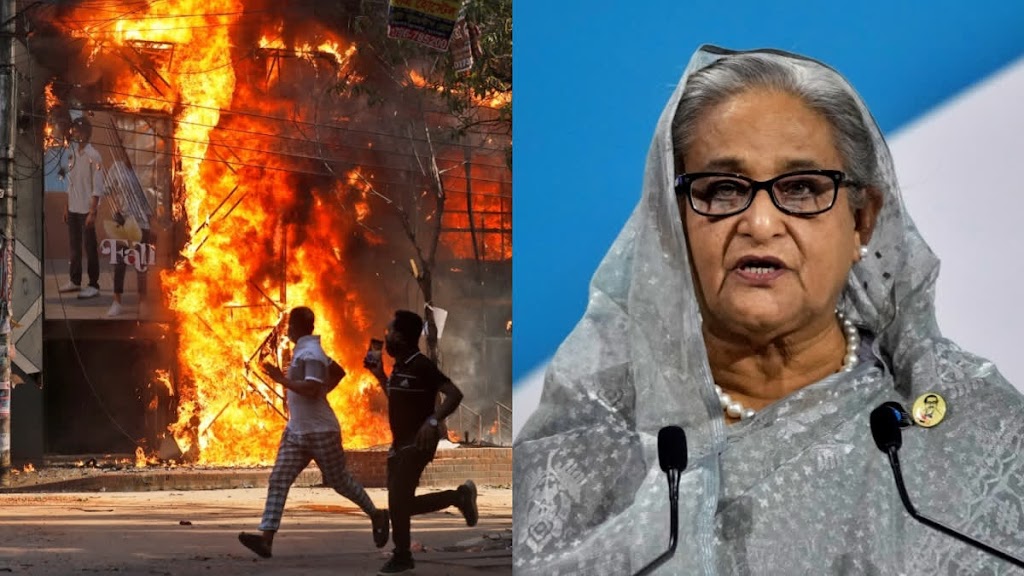APSC Mains Solved Question Papers with Answers | APSC Mains Exam 2022
Hello, aspirants are you preparing for APSC? If yes, then you must be aware of the APSC Mains Solved Question Paper. Therefore every aspirants of APSC Civil Services Exam need to prepare the APSC Mains previous year solved question papers after clearing the Prelims exam. So that “World_Polity” decides to provide you the complete APSC Mains question paper with answer of 2022 for upcoming APSC Mains exam preparation. APSC Mains paper solutions have been meticulously prepared after thorough research, with strict adherence to the Word Limit suggested by APSC for each question. The APSC Mains paper solution is also very helpful & useful for all other State PSC Exams. So APSC Mains Solved Question Papers 2022 will be a pedestrian to crack your future Assam Civil Services exam.
APSC Mains Paper Solution
APSC Mains Solved Question Papers with Answers
In this article we have provided you Main Features of Indian Renaissance APSC Mains Question with Solutions for preparation. So, read this APSC Mains Solved Question Papers with Answers 2022. To give you the best we are here with our special article regarding Solved Mains question paper of Assam Public Service Commission Exam 2022.
APSC Previous Year Solved Question Paper
In order to succeed in the prestigious APSC Civil Services examination, it is important that the aspirant has access to the latest updated syllabus and uses’ the best study material to prepare for the APSC examination. Specially the toppers recommend that aspirant start their APSC preparation by preparing APSC previous year solved question papers.
• Download General Knowledge E-book for Competitive Exam – Click Here
• Download APSC Mains Question Papers 2022 – CLICK HERE
APSC Mains Solved Question Papers 2022
Well here is the APSC Mains Solved Question Paper of 2022. Check this APSC previous year solved question Main Features of Indian Renaissance to prepare for future APSC Mains Exam.
• Main Features of Indian Renaissance APSC Mains 2022
The Indian Renaissance, also known as the Bengal Renaissance, was a significant cultural, intellectual, and social movement that emerged in the 19th and early 20th centuries in India, primarily in Bengal. It marked a period of rejuvenation, reform, and resurgence in various spheres of Indian society.
In the 19th century society of India faced a lot of trouble regarding religious superstitions. This became very complex and many rituals related to it like animal sacrifice became a part of worshipping god. This feels an unhealthy impact on human life and social conditions have also become very depressing. The situation became very pathetic and to remove this a new set of ideas came into existence. This is also a socio intellectual revolution in the field of science, literature, philosophy, political and social reforms and this is known as the Indian Renaissance.
What is meant by Renaissance?
Renaissance is a French word and it means ‘rebirth’. It is a concept of European civilisation and is held to have been characterised by a surge of interest. This process also means the exploration and discovery of new continents. The growth of commerce, the decline in the feudal system, and the potentiality of powerful innovations are the concepts in this study. It means the rise of humanism because it was expressed earliest by the intellectual movement called humanism. It gives a new dimension to culture and art and creates awareness among people. The origin of this process is from Italy and can be found in the period from the 14th to 17th century.
Father of Indian Renaissance and Contribution
Raja Ram Mohan Roy, the founder of Brahma Samaj is called the father of the Indian Renaissance. This man tirelessly fought against the social evils that are prevailing in Indian society. He was the person who broke many traditions for the sake of society. Child marriage and sati pratha are the social barriers that are removed by the man. The effort of this person in these matters helps him to be introduced as the father of Indian Renaissance. Reformist religious associations are conceived by this person as instruments of political and social transformations. Brahma Samaj was also established by this famous person and it played a crucial role in establishing a modern Indian Society. It also helps in suppressing the dowry system, caste system, and improving the educational system.
Main features of Indian Renaissance
Indian renaissance is a concept of rethinking and it is also a rebirth for many aspects of India. Here are some of the main features of the Indian Renaissance:
1. Intellectual Awakening :
The Indian Renaissance was characterized by a flourishing of intellectual pursuits, including literature, philosophy, science, and art. Prominent figures such as Rabindranath Tagore, Swami Vivekananda, Bankim Chandra Chattopadhyay, and Raja Ram Mohan Roy played instrumental roles in this intellectual awakening.
2. Social and Religious Reform :
The Indian Renaissance witnessed significant social and religious reform movements aimed at challenging regressive practices and promoting social equality. Raja Ram Mohan Roy, often regarded as the pioneer of social reform, fought against practices like sati (widow burning) and advocated for women’s rights and education. The Brahmo Samaj and other reformist movements emerged during this period.
3. Promotion of Vernacular Literature :
The Indian Renaissance encouraged the development and recognition of vernacular languages and literature. There was a renewed emphasis on the use of regional languages, particularly Bengali, in literary and intellectual works. This contributed to the growth of regional literature and the expression of local cultural identities.
4. Nationalist Awakening :
The Indian Renaissance played a vital role in fostering a sense of national awakening and promoting nationalist sentiment. Scholars and thinkers began to explore India’s rich history, cultural heritage, and philosophies, leading to a rediscovery of national identity and a desire for political emancipation from British colonial rule.
5. Promotion of Education :
The Renaissance period witnessed a focus on education and the establishment of educational institutions. The emphasis on education was aimed at promoting literacy, scientific knowledge, and modern learning among the Indian population. Institutions such as the Hindu College (later known as Presidency College) and Bethune College were established during this time.
6. Women’s Empowerment :
The Indian Renaissance saw efforts to challenge traditional gender roles and promote women’s empowerment. Women like Pandita Ramabai, Swarnakumari Devi, and Kadambini Ganguly emerged as prominent figures in various fields, including literature, social reform, and medicine.
7. Interactions with the West :
The Indian Renaissance involved interactions and exchanges with Western ideas and philosophies. The influence of the European Enlightenment and the contact with Western education and literature played a role in shaping the intellectual and cultural landscape of the period.
Phases of Indian Renaissance
First Phase :
• The first phase of India’s renaissance was embodied in socio-religious movements, which were primarily, but not exclusively, initiated by the country’s burgeoning middle class, which was educated in British liberalism.
• However, the intellectuals who led the movement were not Anglophile Indians.
• An inquiry into the past and an assessment of the strength of tradition to overcome contemporary problems was a defining feature of the movement.
• For example, Ram Mohan Roy’s use of Hindu scriptures in his Sati debate with his opponents, or Ishwar Chandra Vidyasagar’s widow remarriage campaign, or Narayana Guru’s universalism advocacy.
• In a “era of darkness,” they were all looking for a way out.
• The fact that they targeted the obvious—social obscurantism, religious superstition, and irrational rituals—was a foregone conclusion.
• As a result, the first phase of the Indian renaissance was primarily concerned with social and cultural issues, resulting in a relative neglect of political issues. In fact, politics did not play a significant role in their thinking.
Second Phase :
• The second stage, on the other hand, was defined by an attempt to reconcile anti-colonial politics with the social quest for modernity.
• The anti-colonial movement did not follow the renaissance, as is commonly assumed; rather, the latter elided into the former.
• The national movement allowed the values of the first phase of the renaissance to form their ideological postures and enter areas where they had previously been conspicuous by their absence.
• However, the national movement took precautions to keep the social issues struggle off its political agenda and to control it through measured interventions.
• Gandhiji’s role in the Vaikom Satyagraha, for example, was that of a mediator rather than a participant, despite his sympathies for the satyagrahis.
Third Phase :
• The Convergence of Marxism and renaissance values resulted in the third phase of the renaissance, which began with the end of colonial rule.
• Indeed, renaissance values are inherent in Marxism and were part of the communist movement’s agenda, which functioned with the concept of cultural and social equality, across caste and gender.
• Egalitarianism, gender justice, and secularism were also central to the first and second phases of the Renaissance.
• The Left’s goal was to transform existing cultural and social practices rather than “reform” them.
• Despite the fact that several leaders of the Left Movement recognized the importance of culture in popular struggles, they were unable to creatively bring them together.
• Despite a promising start in the 1930s, the third phase of the renaissance, as represented by radical cultural activism, did not take off.
• The negative consequences of this failure have plagued the Left renaissance to the point where cultural activism has almost become irrelevant in national cultural life.
• This is surprising given that a sizable portion of the creative intelligentsia is intellectually liberal.
• Many cultural activists and writers have begun to wonder whether a “Left Renaissance” is even possible.
Significance of Indian Renaissance
• The renaissance represented the first efforts to redeem India from its state of all-around degradation and to spread this spirit of revival and recreation from sphere to sphere of national life.
• The socio-reform movement created a social climate conducive to reform. This was an attempt to revitalize the socio-cultural system by transforming the existing social milieu.
• It rekindled faith in India’s glory. In the face of the imperialistic disintegration of Indian society and culture, they instilled a sense of self-respect and new confidence.
• They served as a cultural fortification against the assault of colonial culture. They were crucial in the quest and struggle for a new cultural identity and autonomy.
• Since the first reaction against colonialism took place in the cultural arena, the ideas and activities of reformers were inextricably linked to the task of nation-building.
• It made a significant contribution to the birth of Indian nationalism.
• They were a national movement that had an impact on people all over the country, not just in isolated areas.
• People felt a sense of oneness as a result of reform activities and attacks on institutions such as caste, which hampered social creation.
• Indian nationalism aims to regenerate the entire Indian society, regardless of caste or community. The nationalist addressed all social ills on a national scale.
Impact of Indian Renaissance
• The reformers’ goal was never to replace India’s indigenous culture with Western culture. Rather, they simply assimilated some Western values that they saw as desirable for societal development, such as humanism.
• They placed a greater emphasis on the interpretation of scriptures and the simplification of rituals rather than outright imitating Westernization.
• Swami Vivekananda sought reform by reinterpreting the Vedas in the context of a changing world. He emphasized the ideal of selfless service and action.
• Similarly, while Raja Rammohan Roy admired Western thought, he held the Vedas and Upnishads in the highest regard.
• Ishwarchandra Vidyasagar used ancient texts to argue that widows should be allowed to remarry. His suggestions were adopted by British officials, and a law allowing widow remarriage was passed in 1856.
• Such thinkers were opposed to certain social evils such as Sati, idolatry, polytheism, untouchability, and so on, but they believed in the essence of scriptures as a persuasive truth, which was incompatible with modern notions of equality and dignity of all individuals.
• In India, social reform did not typically imply a reorganization of society’s overall structure for the benefit of underprivileged social and economic classes, as it did in the West.
• Instead, it meant infusing new ways of life and thought into the existing social structure; the society would be preserved while its members would be transformed.
The Indian Renaissance was a period of immense intellectual and social transformation, fostering a spirit of critical inquiry, reform, and cultural resurgence. It laid the foundation for the Indian nationalist movement and contributed to the shaping of modern India.
Frequently Asked Questions ::
1. Who is the father of the Indian Renaissance?
Ans : Raja Ram Mohan Roy is known as the father of Indian Renaissance. This person made remarkable changes in the 18th and 19th centuries in India and that is why he is called so. The removal of sati pratha is his remarkable action.
2. Who were the leaders of the Indian Renaissance?
Ans : Indian renaissance provides the name of some of the leaders who helped in this renaissance. Some of them are Annie Besant, Swami Vivekanand, Raja Ram Mohan Roy, Swami Dayananda Saraswati, Virchand Gandhi and many more.
• Must visit : Elaborate Big Fat Indian Wedding APSC 2022
• Must visit : Indian Women as an Untapped Human Resource APSC 2022
• Must visit : How is the Right to Privacy protected in India and Germany APSC 2022
• Must visit : Vallabhbhai Patel in Strengthening the Indian Nation APSC 2022
• Must visit : Role of Mann ki Baat Programme of PM of India APSC 2022
APSC is considered as one of the toughest exams in Assam and is conducted with tight security. Those who secure merit in this, he or she shortlisted for the next round, the APSC Viva interview.
Now World_Polity is on every platform you can connect with us by just clicking the below social media links. Thank You.
• Subscribe our Youtube channel
• Join our Facebook Page
• Join our telegram Channel
* Recent Top Most Searches :
Well if you like this article on Main Features of Indian Renaissance for APSC – APSC Mains Solved Question Papers 2022, do comment & show your support by sharing it to the other aspirants and if there is any query you are welcome to ask.



